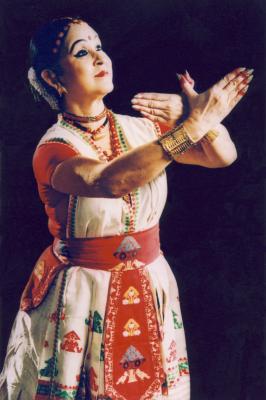|
Sankardeva created Sattriya Nritya as an accompaniment to the Ankiya Naat (a form of Assamese one-act plays devised by him), which were usually performed in the sattras, as Assam's monasteries are called. As the tradition developed and grew within the sattras, the dance form came to be called Sattriya Nritya. Today, although Sattriya Nritya has emerged from within the confines of the sattras to a much wider recognition, the sattras continue to use the dance form for ritualistic and other purposes for which it was originally created circa 500 years ago.
The core of Sattriya Nritya has usually been mythological stories. This was an artistic way of presenting mythological teachings to the people in an accessible, immediate, and enjoyable manner. Traditionally, Sattriya was performed only by bhokots (male monks) in monasteries as a part of their daily rituals or to mark special festivals. Today, in addition to this practice, Sattriya is also performed on stage by men and women who are not members of the sattras, on themes not merely mythological.
Sattriya Nritya is divided into many genres: Apsara Nritya, Behar Nritya, Chali Nritya, Dasavatara Nritya, Manchok Nritya, Natua Nritya, Rasa Nritya, Rajaghariya Chali Nritya, Gosai Prabesh, Bar Prabesh, Gopi Prabesh, Jhumura, Nadu Bhangi, and Sutradhara, to name but a few. Like the other seven schools of classical Indian dance, Sattriya Nritya encompasses the principles required of a classical dance form: the treatises of dance and dramaturgy, like Natyashastra, Abhinaya Darpana, and Sangit Ratnakara; a distinct repertoire (marg) and the aspects of nrtta (pure dance), nrtya (expressive dance), and natya (abhinaya).
Sattriya dance consists of three distinct parts - Guru Vandana, Ramdani and Geet Abhinaya. The first two is performed without any music and to a great extent still remains unaffected by changes. It is only in the third part, based on the childhood tales of Lord Krishna, that the dance form now gets a facelift.
In the second half of the 19th century, Sattriya Nritya emerged from the sanctum of Assam's sattras. It moved from the monastery to the metropolitan stage. The sattras had maintained certain rigid disciplines and austerities within their walls, and until the first half of the 19th century this dance style was performed in a highly ritualistic manner by male dancers alone. The classical rigidity, the strict adherence to certain principles, and the non-engagement of academic research on the dance form all contributed to the delayed recognition and acceptance of Sattriya Nritya as one of the eight classical dance forms of India. On 15 November 2000, the Sangeet Natak Akademi finally gave Sattriya Nritya its due recognition as one of the classical dance forms of India, alongside the other seven forms.
Sattriya Nritya is accompanied by musical compositions called borgeets (composed by Sankardeva among others) which are based on classical ragas. The instruments that accompany a traditional performance are khols (drums), taals (cymbals) and the flute. Other instruments like the violin and the harmonium have been recent additions. The dresses are usually made of pat, a type of silk produced in Assam, woven with intricate local motifs. The ornaments, too, are based on traditional Assamese designs. |








